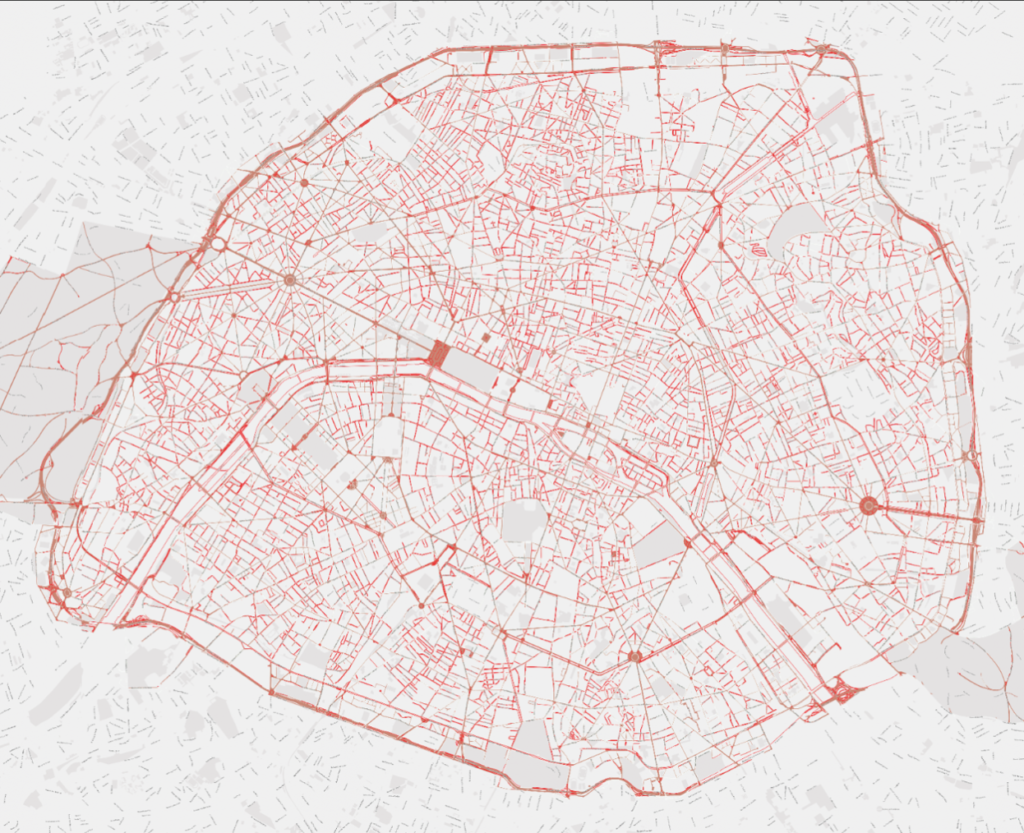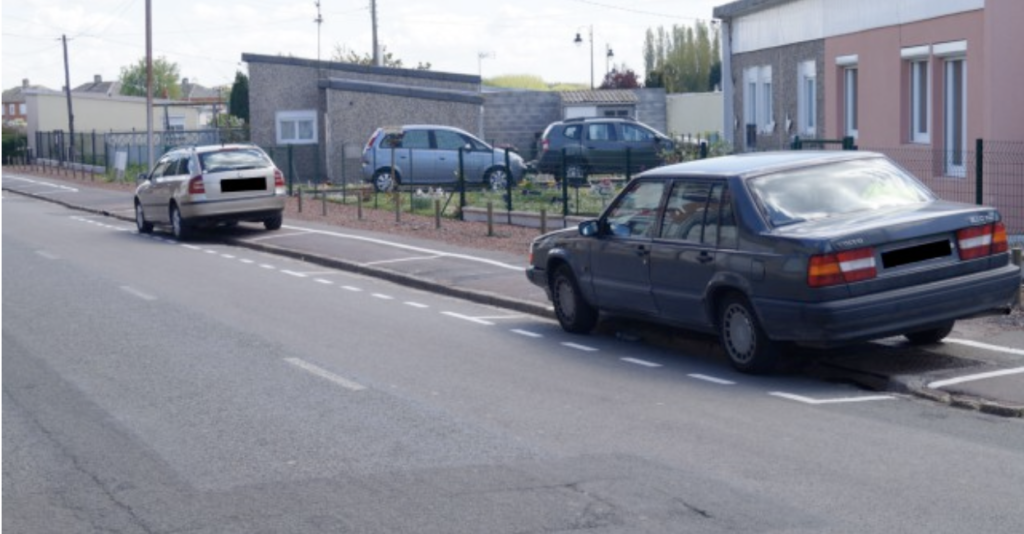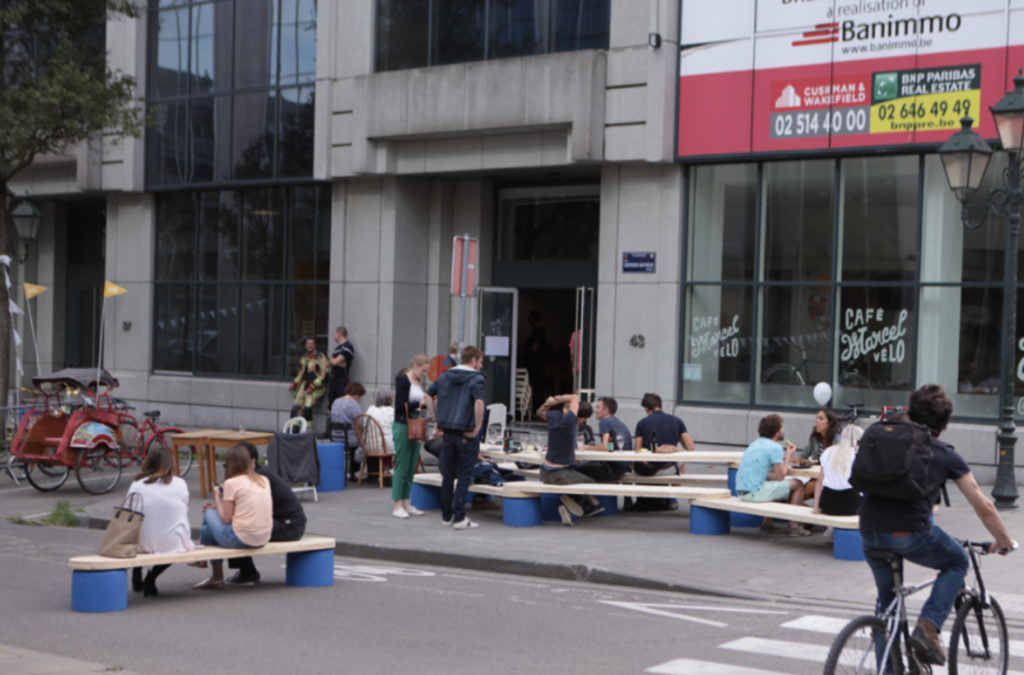Eight challenges and a package of proposals so that physical distancing does not have us die of grief.
One point in the French prime minister Edouard Philippe’s address on TV last Sunday (April 26th) has to be remembered: the shift from the terrible and much misnamed “social distancing” that prevailed until that day, to the “physical distancing” stance. However, the global challenge in front of us remains huge; but at least, it becomes liveable. How to revive desirable shapes of social life while respecting sufficient distance, while not relying on a potentially ineffective tracking App. which presents risks in terms of personal freedoms?
Whereas any virtuous economic and social recovery includes walking, public space, as we know and practice it, does not enable citizens to respect the minimum distances that are recommended. For two people passing each other within a 1 meter distance, a pavement of 2 to 2.5 meters is needed; Actually, the average width of French sidewalks is 1.5 meter (far below the PRM – People with Reduced Mobility – standards).

In red, the Parisian sidewalks with a width below 2.5 meters that will not allow physical distancing to be respected. Some data can be wrong (e.g. Canal de l’Ourcq) or outdated (2013).
For kids during the shelter-in-place period: take your pencil and from the Montparnasse station, try to reach the Porte de la Villette without walking on a red sidewalk. It could take you a while! Download the HD
Simulation by Vraiment Vraiment based on APUR 2013 data basis and OpenStreetMaP.
Contrary to what we could imagine intuitively, it must be noted that the most densely populated territories are not worse off than suburban, see rural ones. While it is true that the width of Parisian sidewalks is not generous, the situation is even worse in places where urban planning has been invariably biased towards cars over the last forty years.

Typical sidewalk in a suburban area. Although prohibited in 2001, these types of schemes are still thriving everywhere for two reasons: the preference of residents for having their car parked “just in front of the house” and the mayors’ strong reluctance to go against it.
Such a failure of public space is, of course, exacerbated by the current situation; it blatantly reminds us that access to and use of public space is unevenly and unfairly distributed across its different users. Actually, most of it is de facto “penned in” for private cars which occupy 50% of the available space when they account for only 11% of movements.
This implicit prioritization is not only a matter of square meters; it also concerns quality. Roads are homogenous and “barrier free”; if any deterioration that could alter the flow occurs, maintenance teams will intervene within several hours. On the contrary and in many cities, the pavement or the cycle paths (if any), narrows with the buildings misalignments, the poles (meant to prevent car drivers to pull over), electricity boxes, ill- or illegally parked motor bikes, a scaffold which should have been taken away weeks ago, bulky refuses or waste containers… In short, even an ideal 3-meter wide sidewalk only offers a 1,5-2 meter wide effective flow. Less than enough to eradicate the epidemic.
In order to meet conditions that would allow the local economy to recover a minima and stop our mood from collapsing, cities have to take up eight challenges (at least).
1. Solutions that reconcile “physical distancing” with “social proximity” must be foundurgently (Sylvain Grisot).
If we cannot do that, we risk dying of grief. Due to the crisis, many citizens have re considered the functions and uses of their balcony. Such new uses show our appetite for solutions and our ability to find some and that it is not impossible to maintain (see reinforce) social connection while implementing distancing rules. The stakes of social cohesion is far from being incidental: the « sliding syndrom », which affects more and more residential facilities for dependent elderly people, is a true signal.
Massive areas of public space have to be returned rapidly to civil society and restored in its socializing function. For this purpose, we can mobilize two “surface tanks”: open space car parks and roads with more than 3,5-meter width. In the footsteps of New York and Milan which are giving back respectively 120 and 35 kilometres of roads to pedestrians, the real challenge consists in sanctuarizing massive parts of public space, not in banning cars in two or three cobbled alibi streets (which would then generate crowd effects that are not consistent with sanitary measures).
This is a major challenge for urban planning departments and road authorities: how to reconcile emergency measures and actions with ongoing structural transformation while keeping a special focus on implementation (design, street furniture, integration of micro local behaviours and habits) with a view to the long term strategy.
2. As a priority, public space will be allocated to less space consuming ways to get around.
We need to propose alternatives to public transportation and avoid a sudden shift from public transport to private car. Within the context of limited available surface (public space cannot be extended infinitely), individual car is the least effective means of transportation. For example, the Parisian regional public railway (RER A) carries more passengers than the Paris ring road. In “normal” times, this highway suffers from congestion 18 hours per day and it will be quite useless when it comes to absorb the modal shift. A 20% increase in traffic is enough to saturate it when well dimensioned cycling and pedestrian infrastructures can absorb 300 to 400% load increases.
The new Parisian cycle routes have clearly shown their capacity to absorb sudden increases during the 2019-2020 strike in public transport. However, there are still congestion points (especially on crossroads) that will have to be reduced in order to respect the physical distancing rules (by adapting the width of runways and promoting ways to behave properly in order to comply with minimum distance while cycling).
If you want to know more about cities that are presently adapting their network of cycling routes, please go to the daily updates by Adrien Lelièvre and Mathieu Chassignet.
3. New kinds of spaces that will enable us to imagine and implement new forms of sociability that remain to be defined see identified, still have to be “invented”.
Shall we meet each other in parks in the future? What changes for our picnics? Will public libraries project contents on their walls and windows devising a European-wise drive in? And last but not least, will public authorities be bound to regulate city noises, so that two people respecting the distance rules could hear each other.
Generally speaking, there is a need to reconsider public space as a continuation of some public or public interest equipment with various functions like an extension or a decontamination chamber: terraces or fore-courts could be used as meeting points and visiting persons in hospitals and retirement homes, school yards could be enlarged…
By taking for granted that sidewalks and parking spots can coexist “peacefully” (see the parklet arrangement) cities should be able to implement ideas and projects that enable public equipments and local shops to resume their activity even though everything will take up more space (display units, terraces, waiting queues…)
4. The collapse of inside sociability places will need to be counter-balanced.
Pressure on public space will be very strong especially as inside spaces of sociability will be scarce: if cultural places, shopping centres, cafés, small businesses remain closed, if summer 2020 is particularly hot (for the fifth month in a row, temperature have been 5 degrees higher than average ones at the same period over the last fifty years), if summer holidays are greatly impacted by the economic recovery, then public space will have to be in capacity to host a wide range of games, shows, parties or romantic strolling. This is not absurd from the sanitary point of view: with fresh air and UV rays (which are potential allies to fight against Covid 19), outside could be safer than inside.
5. Public space will be distributed equally between passage segments and strolling areas.
Under the pressure of emergency, many municipalities are opening temporary cycling roads. This search for efficiency in flows must be supplemented by equivalent imagination in terms of areas dedicated to strolling and sociability. Public space is a window to the world and we must not let Covid deprive us of this window: a place where one can both see and be seen, experience the day by day awareness of others – to love it, to be offended by it, to enjoy it or to worry about it – face strangers and strange events, be surprised by a man or a woman wearing funny clothes, marvel at a young child’s awkward first steps, get hooked on watching a skater attempting the same figure for the tenth time… All these “nothings” are what we do when using a park bench or a chair on a terrace, when standing on the doorstep or on the balcony.
Special attention will have to be dedicated to finding compromises between axes where people circulate and areas where they just stand. We should avoid the situation of the Seine river banks in Paris (where cohabitation rules between strolling pedestrians and hurrying cyclists on their way to work remain to be invented) or the conflicts of use in the Bois de la Cambre in Brussels (presently closed because of the epidemic). In the many new shared areas that will be created, local authorities will have to regulate periods of shared usages and others meant for specific ones.
6. Reconciling top-down visions with a participative bottom-up process based on micro local specific facts and features.
Large urban areas are all facing the same political challenge: how to reach political consensus that can be effectively supported by the communities that constitute the area? In Brussels the sub-regional authorities are presently facing problems with municipalities that support the “one citizen = one car = one parking spot” theory as a human right. The stakes are all the higher as the epidemic imposes the implementation of “temporary” solutions, the quality and efficiency of which depend on their capacity to form an urban continuum. However, that does not mean that top down must prevail in the design of these solutions. Quite the opposite, the long term success of the options that will be validated within the coming weeks relies on the capacity to reconcile a global large scale strategy with micro local identities and uses.

2010. Turning the Place Royale (Brussels) into a pedestrian public space. Vraiment Vraiment was leading on this project which mixes the widening of sidewalks and the creation of “micro spaces” that are dedicated to making a break, enjoying the view of monuments from different angles…
7. In-depth and careful thinking on the forms of these public spaces: “quick” does not mean “dirty”
Concrete motorway curbs, cheap “street furniture” made of pallets, sunbeds (“Place Making”, the American way) and plastic red and orange cones are not the only elements than can materialize newly opened pedestrian spaces. Emergency cannot justify the bypassing of a design phase that mixes urban and landscape approaches. The way these new spots will insert in the city, the choice of objects and floor marking that will become “concrete symbols” for citizens require an in-depth analysis and evaluation prior to any decision.
This phase must meet several requirements:
- Search for local solutions based on materials that can be found on the territory.
- A specific survey of the ergonomics and usability of objects in concertation with people who will be in charge of installing, managing, operating, maintaining and monitoring them but also those persons who will be indirectly involved in the deployment: the police, the street cleaning teams, the middle management… From experience, we know that this is a sine qua non prerequisite to long term success and public appropriation as a component of the urban landscape and functionalities.
- Special attention paid to the “semantics” of all the elements that will delimit such spaces: signposting, objects, ground marking… They must be clear for everyone, including persons who do not know the road traffic rules. Designers have to invent new ways of signifying things, of elaborating on sharing rules. Brussels proposes a “20 km/h plan” which includes absolute priority for pedestrians in any place in the public space. Now the challenge is: Which signposting will enable pedestrians to feel legitimate and safe in an environment which is unconsciously perceived as dangerous after 50 years of unchallenged domination by motor vehicles?
- Capitalizing on THE strength of the place: a small park nearby, an alignment of local shops which deserve some more space outside, a bunch of trees (its shade being quite useful in summer).
- No standardization of the city through standard layouts, standard urban furniture or colours. Micro local specific nature and features have to be taken into account. More than this: they must be the basis of the design. Some designers offer “tool boxes” to local authorities which can choose and combine elements. This approach can help decision makers to articulate global urban planning and micro local realities.
- A strategy which mixes transition and long term; every decision must be the “preview” of a possible sustainable option for the future. This means that these “emergency solutions” must be based on evaluation criteria that have been validated by consensus and on accurate measuring instruments. Many count tools for cars are available on the market but only a few of them can count pedestrians. When it comes to weak signals such “how do people use this part of public space?” or “is this street really alive?”, there is still a lot to do before we can really objectivise things.

8. Emergency of course… but « inclusive » must be the watchword for this transmutation of public space
“Jogging” is the only activity that is recognized during the lockdown. This exclusive privilege is questionable: No gender issue there but a strong social and generational marker going against the definition of public space which must be designed and organized as a space for freedom, open to different cultures and habits.
This openness:
- Must not normalise usage, a fortiori such a socially marked activity even though sometimes, some temporary occupation strategies may, for example, be biased and deploy ethnocentric visions of public space
- Cannot in any case reinforce exclusion or invisibilisation of certain categories of persons, first and foremost women.
* * *
Like (to a much lesser extent) with the blooming of free floats bicycles and scooters some years ago, physical distancing urges us to reconsider public space in terms of scarcity, potential conflicts and functionalities. Due to the epidemic, public space management, which used to be a technical matter, becomes a full-fledged instrument of the resilience of urban and rural territories, especially in cities that started to work on it years ago (e.g. Paris).
Incidentally, local authorities cannot do without the support of civil society and those among them (like APUR : Paris urban agency) which open access to data on public space and work on how to share it will doubtlessly gain in legitimacy and recognition. These data, in addition to many future ones, contribute to the development of decision support tools which will be more and more powerful and efficient as they will integrate real data on utilization of spaces and accurate ones on weak signals such as strolling practices, sociability, easing of tensions…
Many of the projects that were in the design phase would gain in being reviewed and amended in the light of this unprecedented situation. In the same vein, local administrations which had just started a design process of urban mobility planning that give walking and cycling a central place now have a wider than ever field of possibilities.
The Vraiment Vraiment team of experts has an extensive experience in tactical urban planning, public space re-designing and temporary occupation of space. We constantly and systematically give highest priority to quality in urban fabric, to the political meaning of choices and to aesthetic quality of the projects entrusted to us. We are proud of contributing to the functional renewal of public space alongside local authorities which have honoured us with their trust.